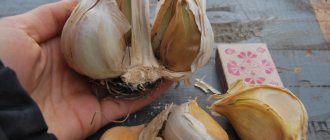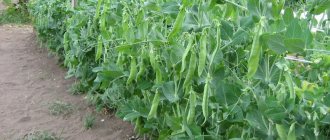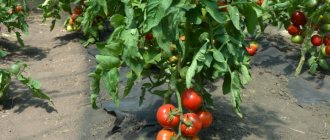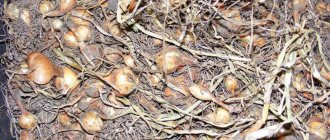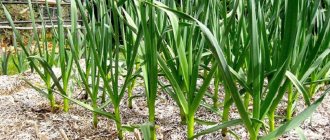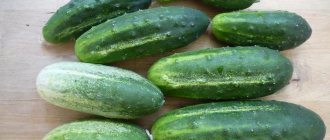General description of the crop, types and varieties
All varieties are usually divided into two main subspecies:
- winter crops - planted in autumn;
- spring - intended for planting in spring.
There is a secondary division into two groups:
- shooting type - instead of seed material, they form small bulbs with one clove;
- non-shooting - these include species grown in the spring months.
Large garlic
When understanding the question of how to grow large garlic, you should immediately understand that large heads come from winter varieties. Their peculiarity is the short-term storage of the collected fruits - in the last cold month the crop begins to deteriorate. Summer varieties have a shelf life of 2 years.
Important! Preference is given to varieties depending on needs: for sale or self-consumption.
Choosing a variety: spring or winter
Each of them has both advantages and disadvantages . The choice of a gardener is determined by an understanding of these features.
Winter varieties:
- winter well under snow at low temperatures (down to -40° on the surface);
- disease resistant;
- have a rich, pungent taste;
- are characterized by high productivity;
- they bring large onions with neat, even teeth;
- harvest in late July - early August;
- Shelf life – up to 4 months.
Spring varieties:
- at the planting stage, preliminary germination is required;
- the yield is low compared to winter crops;
- large heads are obtained only from special varieties (for example, Gulliver);
- teeth of different sizes;
- reaches maturity by the end of August;
- Storage duration is up to two years.
The process of planting in open ground in the garden
The timing of planting work plays an important role:
- Wintering - planted in September-October, which allows the plant to take root before the first frost. Only with this approach will it give good results and calmly survive the cold.
- Summer - planted in April, can germinate at soil temperatures from +6 degrees.
Important! What to do to make garlic large: a logical approach to growing and following the recommendations will allow you to harvest the desired volume of vegetables of the required quality.
Planting garlic
Selection and preparation of planting material
Preparatory activities begin with determining the type of seed material:
- wintering varieties have a central rod, around which there is an even number of cloves - from 4 to 8 pieces;
- in summer ones there is no rod, the number of lobules may vary.
A careful selection of planting material is carried out:
- specimens with signs of rotting, mechanical damage and mold are considered rejected;
- small cloves fused together, a small number of them indicates the degeneration of the crop, the inability to obtain a sufficient amount of garlic - preference is given to bulbs with large cloves.
Before planting, disinfection is carried out:
- 1% solution of copper sulfate or potassium permanganate - immerse specimens for half an hour;
- a mixture of water (2 l) with wood ash (0.3 kg) - the solution is boiled, the light part of the liquid is separated and the garlic is dipped into it for 1 hour.
When preparing summer varieties, follow the following recommendations:
- 30 days before planting, the material is transferred to a cool place with a temperature range of +2 to -3 degrees;
- disinfection is carried out within 24 hours;
- placed in a growth stimulator for 12 hours.
Important! To speed up the formation, summer varieties are germinated in a moistened fabric bag. The structure is additionally insulated with polyethylene film for 48 hours.
Treatment before planting
Rules for planting spring and winter garlic
The secrets of planting garlic include following certain rules. Features of spring planting are presented below:
- preliminary watering is carried out when the soil is dry; when the soil is moist, the procedure is not necessary;
- the standard depth of 3 cm is observed;
- Before sprouts appear, mulch with peat.
In the autumn months, your requirements for the procedure:
- timely planting - the crop must have time to take root, but not sprout;
- Watering is not carried out so that the bulbs do not rot; ash or sand is first poured into the holes;
- planting is carried out with a depth of 5 cm - this reduces the risk of freezing;
- After planting, the soil is leveled and covered with mulch (peat, rotted sawdust) to a depth of 3-5 cm.
Important! When planting in the fall, the area is covered with leaves or spruce branches, and everything is removed after the snow melts.
Preparing a bed for planting garlic
Growing varietal garlic in open ground requires preparing the beds:
- In autumn, the site is dug up 3 weeks before planting. If the requirement is ignored, the planted specimens will become buried along with the movement of the soil, which will lead to a decrease in yield and shorten storage time.
- In the spring - preparatory work is carried out in the autumn months, the soil is dug up to the depth of a shovel. If necessary, apply fertilizers and thoroughly loosen the soil. After leveling the area, it is disinfected with a solution of potassium permanganate, covered with plastic wrap and left in this form until spring.
Landing dates
Planting dates depend on the variety:
- Winter garlic is planted in late September to mid-October so that it has time to take root before the onset of frost, but does not sprouted to the surface. Only in this case will he be able to calmly endure the cold and produce a large harvest;
- The summer variety begins to be grown after the snow melts in early to mid-April. It tolerates cold and can germinate even at a soil temperature of 6 °C. Good garlic can be obtained by planting early. It should be taken into account that the head must form before the onset of hot weather, otherwise the bulbs of spring varieties will not be large.
Garlic needs to be planted and grown properly to produce large heads.
Garlic growing technology
Garlic in a garden bed without high-quality soil moisture, mulching and loosening will sprout late, will not grow to standard sizes and will not produce the expected volume of vegetables.
Proper watering
The culture is moisture-loving and requires compliance with the following standards:
- in the spring, the root system is actively formed; in the first 3 weeks after planting, watering is carried out every 7 days, 15 liters of liquid per m²;
- the frequency and amount of soil moisture is correlated with weather indicators: in cool weather - 10 liters per m², in heat and drought increased to 15 liters per m², maintaining an interval of 5 days;
- in rainy weather, stop watering;
- after each procedure, the beds are sprinkled with sand;
- The water should be warm, standing in the sun.
Important! Over-wetting the soil will lead to the development of fungal infections and damage to plants.
Mulching the beds
When understanding the question of how to properly care for garlic, we must not forget about mulching.
After planting, it is necessary to cover the plantings with mulch. Compliance with the requirements will help preserve moisture in the soil, reduce the frequency of watering, and reduce the number of weedings.
Removing arrows
After they grow by 20 cm, pruning to 5 cm is carried out - with a sharp knife or breaking off the shoots. Removing future inflorescences (arrows) helps increase the amount of nutrients supplied to the bulb.
Timely loosening
The looseness of the soil allows oxygen to penetrate to the root system of the crop. The procedures are carried out after each watering.
Moderate feeding
When telling how to grow large garlic, experienced gardeners remember: timely application of fertilizers helps increase the volume of individual bulbs.
Immediately after the snow melts, the beds with overwintering one-and-a-half-year-old varieties are watered with a urea solution, and nutrients are added as needed. Depleted soil requires feeding up to 2 times a month during this growing season.
When growing summer crops, fertilizers are applied twice per season:
- in the spring months - a solution of bird droppings (1 kg per 10 liters) or mullein (1 kg per 8 liters);
- in the middle of the season - ash solution (1 tbsp per bucket of liquid).
Important! Fertilizers should be used within reasonable limits. An excess of organic matter will stop the formation of the plant and cause the green part to turn yellow. A large amount of minerals will affect the taste and quality characteristics of the crop.
Top dressing
Video: secrets of an excellent garlic harvest
To summarize, it can be noted that growing garlic is easy and accessible to a beginning gardener in any region. By applying the above rules in practice, he will certainly receive a decent harvest of vitamin and healthy products.
- Author: Pyotr Vladimirovich Sadovnikov
Hello! My name is Pyotr Vladimirovich. I am 63 years old. By education, he is a mechanical engineer. Rate this article:
- 5
- 4
- 3
- 2
- 1
(1 vote, average: 5 out of 5)
Share with your friends!
Disease and pest control
Diseases and insects cause additional troubles. Garlic is often attacked by mole crickets, nematodes, and onion moths. To prevent their colonization on plants, use a mixture of 0.25 kg of tobacco and 2 tsp. ground pepper, poured 3 liters of boiling water. The solution is kept for 72 hours, filtered, diluted with liquid to 10 l, add 2 tbsp. l. liquid soap and spray the sprouts 2 times a month. When attacking crops, store-bought insecticides are used.
What disease can affect garlic?
- bottom rot - with the death of the root system, rotting of the bulbs and yellowing of the foliage;
- downy mildew - stopping the ripening process;
- white rot - with the death of the green part and bulbs;
- bacterial rot - with damage to the teeth.
Important! Prevention of disease occurrence is carried out before planting. The material is disinfected with a solution of copper sulfate, wood ash or potassium permanganate.
Storage
To prevent garlic heads from spoiling over the winter and to retain all their beneficial properties and juiciness, it is recommended to store them in salt. Dry heads must be placed in a container with regular table salt and placed in a dry, well-ventilated place.
Some housewives store garlic heads in dry onion peels. To avoid an unpleasant odor, the dried husks are placed in fabric bags, and garlic is also placed there. All winter you will have the feeling that the garlic has just come from the garden - it will remain so juicy and aromatic throughout the entire time.
For convenience and speed of using this aromatic seasoning, some housewives prefer to freeze garlic, making so-called semi-finished products from it. You need to pass the peeled garlic cloves through a meat grinder, put it in small portions into ice-freezing molds, wrap the molds in cling film and place in the freezer for a while. When the garlic cubes are frozen, shake them out of the freezer and place them in a freezer bag with a sealable lid. Using such preparations is very convenient: you can immediately add aromatic seasoning to the dish you are preparing, without wasting time on cleaning. All the beneficial properties and delicious smell are preserved even after defrosting!
I like 1
Garlic Harvest Beds Growing garlic Large garlic Harvest on the balcony Vegetable garden Dacha
Related Posts
leave a comment
Only 1 comment.
Specifics of industrial garlic cultivation
How garlic grows on farms: the principle is the same as when cultivating in the garden, but all actions take place on a production scale.
Rules for planting, care, harvesting per 1 hectare
The amount of planting material depends on its type:
- large size - 1000 kg will be needed for 1 hectare;
- single-toothed - 300 kg;
- puffed garlic seeds - 50 kg.
To obtain the maximum volume of garlic, it is necessary to follow the rules of agricultural technology. Preparing the soil for sowing begins 2 months in advance with the removal of all weeds - manually or using herbicides. In the fall, the land is fertilized with organic matter, 3 weeks before planting, mineral fertilizers are added to it, the calculation is carried out per 1 hectare:
- nitrogen - 100 kg;
- potassium sulfate - from 120 to 200 kg;
- phosphorus - from 100 to 120 kg.
All planting material is carefully checked and discarded, and the healthiest is selected. The destruction of weeds and loosening of the soil is carried out after sowing; all work requires care so as not to damage the root system.
Important! Flower stems are trimmed after they appear. This approach allows you to increase productivity by 25-30%.
The land is irrigated regularly, especially in hot weather. Watering is necessary as the soil dries out, in the morning. Planting of crops is carried out:
- wintering - 20 days before the first frost, develops within 8-9 months;
- spring - in the transition from March to April, when the soil warms up to +5-7 degrees, ripening is expected in 4-5 months.
The list of varieties with average yields intended for autumn sowing includes Spas, Lyubasha, Messidor, Sofievsky, etc. From 20 to 25 tons can be collected from each hectare. Spring varieties are represented by Moscow, Ukrainian White, Kirill, Skorospely, Yarus. When planting them, you can collect up to 15 tons from each hectare.
The collected vegetables are stored at a temperature of 2 degrees and a humidity of 60%. Before being sent to storage, the garlic is dried, selected and sorted into boxes.
Business profitability
Before starting to implement a business idea, a newly minted farmer must decide on production volumes. The investment of material resources and the profitability of the enterprise depend on the size of the territory: for the purchase of seed, equipment and wages of seasonal workers.
At the beginning, it is more profitable to sow a small area and limit yourself to your own efforts. This approach will lead to minimal costs and good income. With a logical approach to the problem, the investment will pay off in the first year of growing garlic.
Regardless of the planting volume, industrial or limited size, the crop requires simple care in compliance with the cultivation stages. Garlic can be planted in the country or near the house and collected enough for personal use. The main thing is to love the process and dare, despite temporary obstacles and difficulties.
How to prepare for planting garlic
To ensure that your plantings delight you with a rich harvest, I advise you to properly prepare the area for sowing garlic.
Soil preparation
Garlic prefers fertile, neutral soil. It grows well on a loamy substrate and loves moderately moist soils. Lowlands and wetlands where melt water accumulates are not suitable.
The soil is prepared in the fall for both winter and spring crops:
- For 1 m2 – 1 bucket of humus, 20 g of potassium salt, 30 g of superphosphate. Fertilizer is mixed with garden soil.
- The area is being dug up.
The bed for winter garlic is leveled after 2 weeks. Under spring crops, they are raked in the spring.
Crop rotation
The best predecessors for garlic beds:
- cabbage;
- legumes;
- pumpkin;
- green manure;
- zucchini.
Unwanted Precursors:
- the root vegetable itself;
- tomatoes;
- cucumbers;
- carrot;
- onion.
Neighborhood with a garlic bed is beneficial for plants:
- gooseberry;
- strawberry;
- raspberries;
- currant;
- potato;
- tulips;
- gladioli;
- roses.
Garlic repels pests from these plantings - caterpillars, slugs and even moles.
